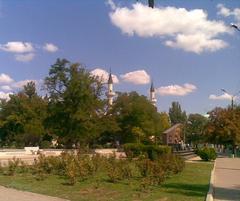
Yuqary Mosque Visiting Hours, Tickets, and Historical Site Guide in Autonomous Republic of Crimea, Ukraine
Date: 04/07/2025
Introduction
Yuqary Mosque, also known as the Upper Mosque, stands as one of Crimea’s most enduring Islamic landmarks and a vital center of Crimean Tatar culture. With origins dating to the late 14th or early 15th century, the mosque is emblematic of the region’s layered history, architectural evolution, and the resilience of its Muslim community. This comprehensive guide presents Yuqary Mosque’s historical background, architectural highlights, cultural significance, visiting hours, ticketing details, etiquette, accessibility, and tips for exploring related historical sites across Crimea.
Table of Contents
- Historical Overview
- Architectural Features
- Cultural and Social Importance
- Visitor Information
- FAQs
- Conclusion and Call to Action
- References
Historical Overview
Early Origins and Architectural Context
Yuqary Mosque is among the oldest surviving Islamic sites in Crimea, established during the late Golden Horde period and connected to the Mongol-Tatar conquest and the founding of the Crimean Khanate (localhistories.org). Its architecture blends local Crimean Tatar traditions with Ottoman and Anatolian styles—characterized by domes, a slender minaret, and geometric patterns (special-en.travelcrimea.com).
Crimean Khanate and Ottoman Influence
During the Crimean Khanate (1441–1783), the mosque was a nucleus not only for religious worship but also for education, community gatherings, and administration. Ottoman influences introduced ornate tilework, pointed arches, and a more pronounced dome, marking periods of architectural flourishing (special-en.travelcrimea.com).
Russian Annexation and Soviet Era
The 1783 Russian annexation triggered a decline, as many Islamic institutions were suppressed or repurposed (localhistories.org). Under Soviet rule, the mosque was abandoned following the 1944 deportation of Crimean Tatars, with its religious functions suspended but its structure preserved as a monument.
Post-Soviet Revival and Contemporary Status
After the Soviet collapse in 1991, Crimean Tatars returned, restoring Yuqary Mosque and reviving its religious and cultural role (en.wikipedia.org). The 2014 Russian annexation complicated preservation, but ongoing restoration and community engagement have maintained its status as an active mosque and cultural center (thecollector.com).
Architectural Features
Yuqary Mosque features a rectangular plan with a gabled roof, a prominent portal, and a single minaret. The mihrab (prayer niche) and minbar (pulpit) are focal points inside, often adorned with geometric carvings and Arabic calligraphy. The mosque’s interior is divided by columns, and natural light filters through pointed-arch windows. Subtle tilework, carved wood, and restrained color palettes reflect Crimean Tatar and Ottoman artistry (iccrimea.org; middleeasteye.net).
Restoration efforts since the 1990s have prioritized structural reinforcement and preservation of original decorative elements (middleeasteye.net).
Cultural and Social Importance
Yuqary Mosque is more than a monument; it is a living hub of Crimean Tatar spiritual and communal life. The mosque hosts daily prayers, Friday services, Islamic holiday celebrations, and community events. It also plays a pivotal role in preserving Crimean Tatar identity and resilience, especially given historical episodes of repression and exile (culture.voicecrimea.com.ua; thecollector.com).
Visitor Information
Visiting Hours and Tickets
- Hours: Generally open daily, 9:00 AM to 6:00 PM. Closing times may shift during religious holidays or special events—check with local tourism offices or the mosque directly before visiting.
- Tickets: No entry fee; donations are welcomed to support maintenance and restoration (en.wikipedia.org).
Guided Tours
Guided tours are often available via local community groups or tourism offices, providing insights into the mosque’s history, architecture, and cultural context. Advance booking is recommended during busy seasons.
Accessibility & Etiquette
- Accessibility: The main prayer hall and courtyard are accessible, though some historic areas may be less so for those with mobility impairments.
- Dress Code: Modest attire is required (shoulders and knees covered); women should bring a headscarf. Remove shoes before entering the prayer hall.
- Etiquette: Maintain silence, avoid photography inside the prayer hall without permission, and respect prayer times and gender separation where applicable (Learn Religions: Mosque Etiquette; Blue Mosque Dress Code).
How to Get There
Yuqary Mosque is centrally located in historic Crimean towns such as Stary Krym and Simferopol. Both are accessible by public transport, taxi, or private car from regional centers. Local tourism offices can provide maps and directions (Simferopol city guide).
Nearby Attractions
Combine your mosque visit with other sites such as:
- Juma-Jami Mosque in Yevpatoria
- Bakhchisaray Palace
- Crimean Tatar Museum of Cultural and Historical Heritage
- Orthodox churches and medieval ruins in Stary Krym
FAQs
What are Yuqary Mosque’s opening hours?
9:00 AM to 6:00 PM daily, subject to change during holidays.
Is there an entry fee?
No; entry is free, but donations are appreciated.
Are guided tours available?
Yes, through local tourism offices or mosque community groups.
Is the mosque accessible for people with disabilities?
Main areas are accessible; some historic sections may have limitations.
Can I take photographs?
Photography is allowed in the courtyard and exterior; seek permission for interior photos, especially during prayers.
Conclusion and Call to Action
Yuqary Mosque is a cornerstone of Crimea’s Islamic heritage and a testament to the enduring spirit of the Crimean Tatar community. Its layered history, architectural elegance, and active religious life offer a unique and meaningful experience for every visitor. Respectful attendance, awareness of local customs, and engagement with community guides can enrich your understanding and appreciation.
For the latest updates on visiting hours, events, and guided tours, download the Audiala app—your companion for exploring Crimea’s remarkable historical sites. Explore related articles on Crimean mosques and heritage, and follow us on social media for travel tips and cultural insights.
References
- A Brief History of Crimea, 2023, Local Histories
- History and Culture of Crimea, 2019, Travel Crimea
- Mosques of the South-East of Crimea in Drawings and Lithographs, 2022, Voice of Crimea Culture
- History of Crimea: Complex and Contentious, 2024, The Collector
- Autonomous Republic of Crimea, 2024, Wikipedia
- Simferopol city guide
- Blue Mosque Dress Code
- Learn Religions: Mosque Etiquette
- Islam in Crimea
- The Present Perspective: Visiting a Mosque
- iccrimea.org
- middleeasteye.net
- architecturecourses.org
- medium.com
- India Today: Crimea’s Status




